 Open Access
Open Access
ARTICLE
Modifications of the Optimal Auxiliary Function Method to Fractional Order Fornberg-Whitham Equations
1 Department of Mathematics, Abdul Wali Khan University, Mardan, 23200, Pakistan
2 Department of Mathematics, College of Science Al-Zulfi Majmmah University, Al-Majmmah, 11952, Saudi Arabia
3 Department of Mathematics and Statistics, College of Science, Taif University, Taif, 21944, Saudi Arabia
4 University Research Centre, Future University in Egypt, New Cairo, 11745, Egypt
* Corresponding Authors: Mehreen Fiza. Email: ; Ilyas Khan. Email:
Computer Modeling in Engineering & Sciences 2023, 136(1), 277-291. https://doi.org/10.32604/cmes.2023.022289
Received 02 March 2022; Accepted 08 August 2022; Issue published 05 January 2023
Abstract
In this paper, we present a new modification of the newly developed semi-analytical method named the Optimal Auxilary Function Method (OAFM) for fractional-order equations using the Caputo operator, which is named FOAFM. The mathematical theory of FOAFM is presented and the effectiveness of this method is proven by using it with well-known Fornberg-Whitham Equations (FWE). The FOAFM results are compared with other method results along with their exact solutions with the help of tables and plots to prove the validity of FOAFM. A rapidly convergent series solution is obtained from FOAFM and is validated by comparison with other results. The analysis proves that our method is simply applicable, contains less computational work, and is rapidly convergent to the exact solution at the first iteration. A series solution to the problem is obtained with the help of FOAFM. The validity of FOAFM results is validated by comparing its results with the results available in the literature. It is observed that FOAFM is simply applicable, contains less computational work, and is fastly convergent. The convergence and stability are obtained with the help of optimal constants. FOAFM is very easy in applicability and provides excellent results at the first iteration for complex nonlinear initial/boundary value problems. FOAFM contains the optimal auxiliary constants through which we can control the convergence as FOAFM contains the auxiliary functions in which the optimal constants and the control convergence parameters exist to play an important role in getting the convergent solution which is obtained rigorously. The computational work in FOAFM is less when compared to other methods and even a low-specification computer can do the computational work easily.Keywords
Fractional calculus deals with the operation of integer order calculus. Earlier fractional calculus has assumed to have no physical applications, but later scientists proved that fractional calculus has many applications in real-world problems such as sound waves propagation in rigid porous material [1], ultrasonic wave propagation in human bone [2], viscoelastic properties in biological tissues [3], and tracking in automobiles [4]. Recently fractional calculus has attracted the attention of researchers due to its vast applications in the field of electromagnetic, physics, viscoelasticity, material science, fluid mechanics, and applied sciences [5–9]. The exact solution has an important role in the solution of fractional calculus. Since most of the Partial Differential Equations (PDEs) have no exact solutions, therefore, the scientist strives for various methods like transformation base methods [10–13], Vibrational iteration method VIM [14], Adomian decomposition method (ADM) [15], Homotopy Perturbation Method (HPM) [16], Differential Transform Method (DTM) [17] to treat the PDEs with no exact solutions. This method required a small assumed parameter or the initial guess. The improper selection of these choices affects the accuracy. The idea of homotopy was introduced in the Perturbation Method (PMs) to develop the Homotopy Perturbation Method (HPM) [18–20] and Homotopy Analysis Methods (HAM) [21] to fix the issue of a small parameter. These methods require the initial guess and have larger flexibility to control the convergence region. To overcome the issue of initial guess, Marinca and Herişanu et al. introduced the Optimal Homotopy Asymptotic Method (OHAM) [22–26]. This method contains the optimal auxiliary function and does not require the initial guess and is hence extended by Ullah et al. [27–31] to more complex models. Herisanu 2019 introduced the Optimal Auxilary Function Method (OAFM) [32] to handle the nonlinear problem. This method is introduced for less computational work and an accurate solution is obtained at the first iteration. Abbas bandy used the HAM for the nonlinear model [33]. Kumar et al. used fractional derivative with Mittag-Leffler-type kernel for the FEW problems [34]. Lu used the VIM for the solution of FEW [35] whereas FEW is solved by Group invariant solutions and conservation laws by Heshemi et al. [36]. Ramadan et al. [37] used the new iterative method and compared its results with HPM results for the FEW models. Merdan et al. [38] used numerical simulations to handle FEW problems. Wang et al. [39] used the modified fractional homotopy analysis transform method for obtaining the FEW solutions. Abidi et al. [40] used the numerical procedure for the solution of the FEW models. The researchers used the semi-analytical methods and numerical methods equally. The numerical methods required large computational memory and processing time for getting the solutions of nonlinear fractional PDEs. The numerical methods required the linearization and discretization procedure and these procedures sometimes affect the accuracy of the methods that is why the scientists used the analytical method to solve the nonlinear fractional PDEs. The applications of these methods can be seen in [41–53].
The purpose of this paper is to modify the OAFM for fractional-order PDEs. FOAFM has been proven effective and is a reliable method to treat complex fractional-order PDEs.
The paper is organized into six sections. Section 1 is dedicated to the introduction. Basic concept and definitions are given in Section 2. The mathematical theory of FOAFM is given in Section 3, the applications of FOAFM to FWEs are given in Section 4. The results, discussion and conclusion are presented in Sections 5 and 6, respectively.
Definition 1. A real valued function
Definition 2. The Reiman-Liouville fractional integral operator
Definition 3. The fractional derivative of the function, f(u), in the Caputo sense
Definition 4: If
3 Analysis of OAFM for Fractional Order PDEs
Let us see the OAFM to nonlinear ODE
where
The initial conditions are
Selecting
Using Eq. (6) in Eq. (4), we obtain
The zeroth approximation is determined as
The first approximation is obtained as
since Eqs. (7) and (8) contain the time fractional derivatives, hence by applying
and
The nonlinear term is expressed as
Eq. (11) can be written as
Convergence of the Method: The optimal constants are obtained by using the Method of Least Squares:
where I is the equation domain.
The unknown constants are established as
Using the values of Es, we find the approximated solution as
4 Implementation of the Method
In this section, we implement the mathematical formulation of OAFM to FWE models.
Problem 1: Consider the FEW of the form
with
where
The exact solution of Eq. (16) is given by [36]
where A is an arbitrary constant.
We consider
Zeroth Order System:
with initial conditions
Its solution is
First Order System:
with
Using Eqs. (19) and (23) in Eq. (24), its solution is given by
The final solution is given by
Applying the method of least square as discussed in Eqs. (13) and (14), we get the values of the optimal constants
We get
Problem 2: Consider the FEW of the form
with
The exact solution of Eq. (16) is given by [39]
We consider
Zeroth Order System:
with initial conditions
Its solution is
First Order System:
Using Eqs. (32) and (36) in Eq. (37), we get
The final solution is given by
Applying the method of the least square as discussed in Eqs. (13) and (14), we get the values of the optimal constants
5 Results Analysis and Discussion
The mathematical theory of FOAFM provides highly accurate solutions for the fractional order Fornberg-Whitham equation as presented in Section 3. We have used Mathematica 11 for our computational work. The results obtained by FOAFM are compared with other methods available in the literature as given in Tables 1 and 2 for both the problems along with the exact solution revealing that FOAFM is valid and more accurate than other analytical methods as FOAFM provides nearly identical results to exact solutions. The absolute errors AEs for both problems are obtained in comparison with exact solutions for different values of fractional order




The solution is again validated by comparing the solutions with exact solutions in 3D and 2D forms for problems 1–2 as given in Figs. 1–3 and 4–6. The residual plots in 3D and 2D form are given in Figs. 7, 8, 9 and 10 for problems 1 and 2, respectively, while the variation of fractional order
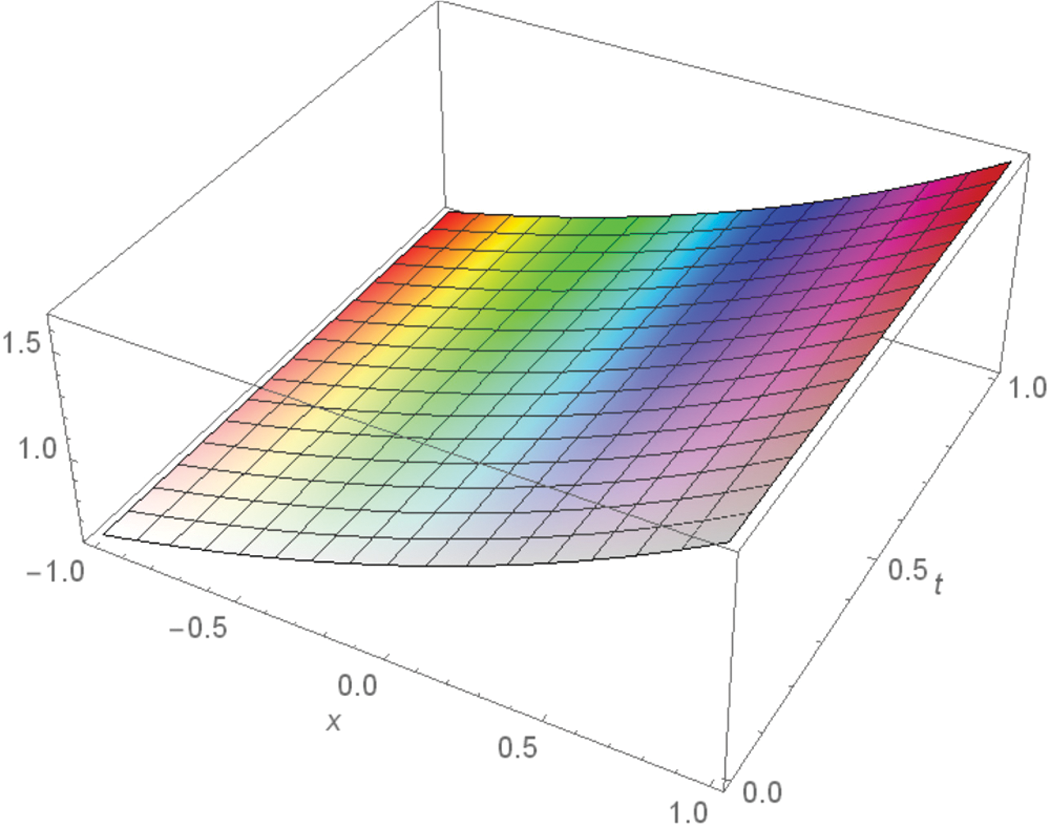
Figure 1: 3D plot of
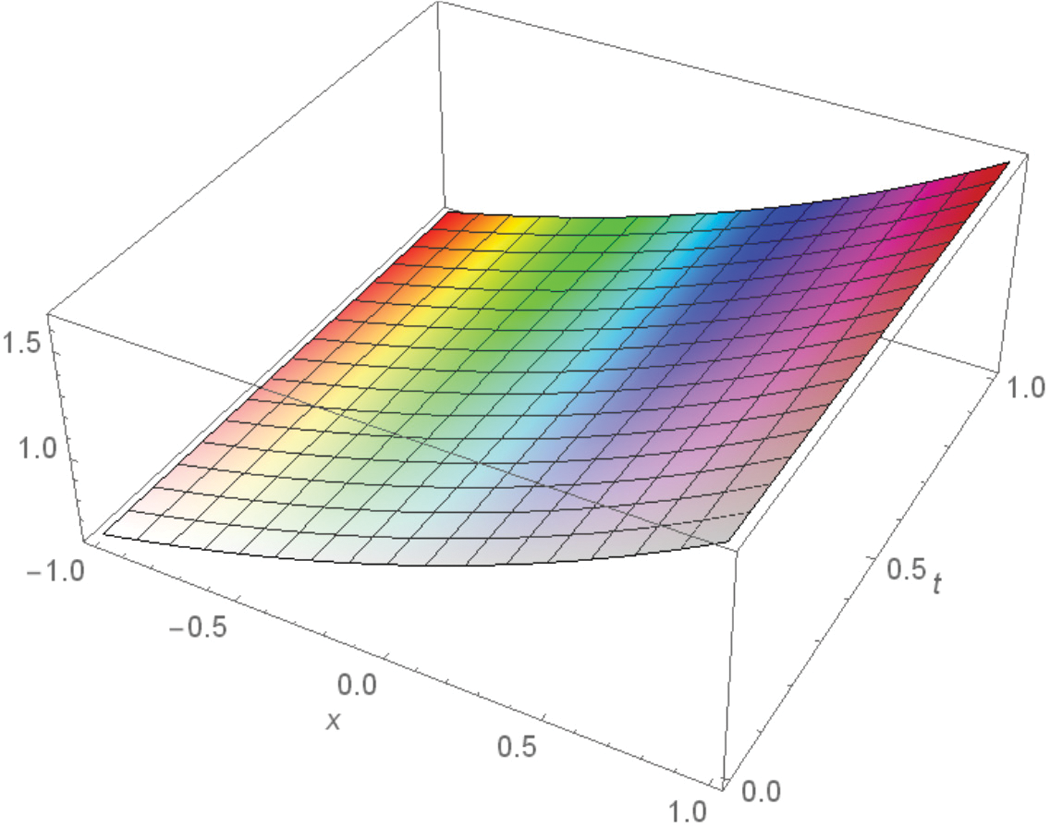
Figure 2: 3D exact solution of
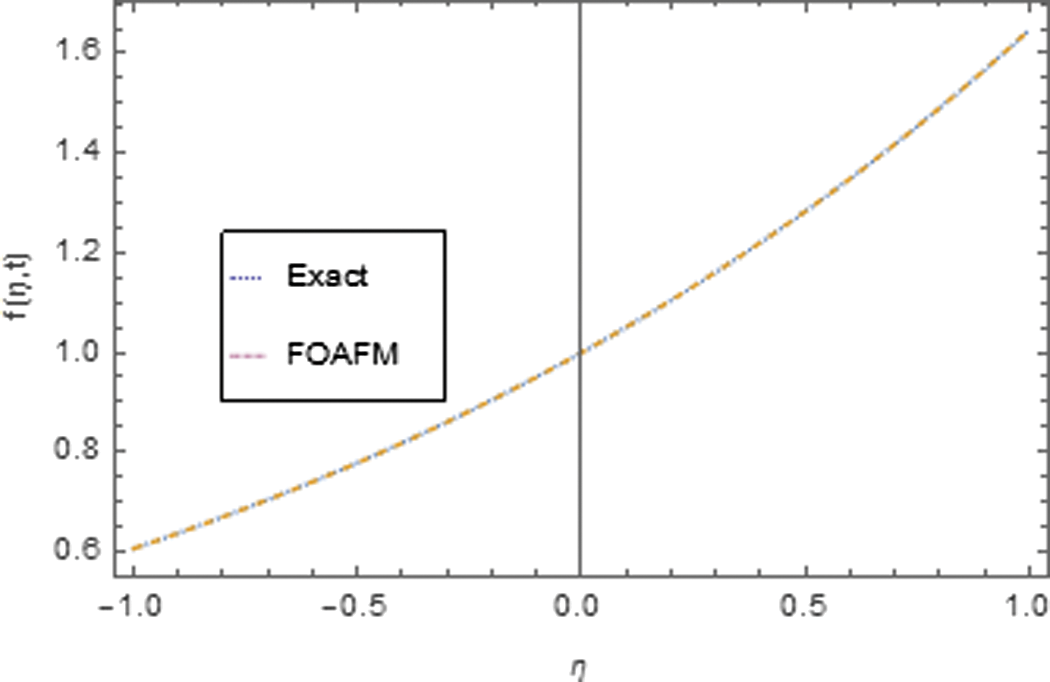
Figure 3: 2D plot of comparison of exact and FOAFM solutions
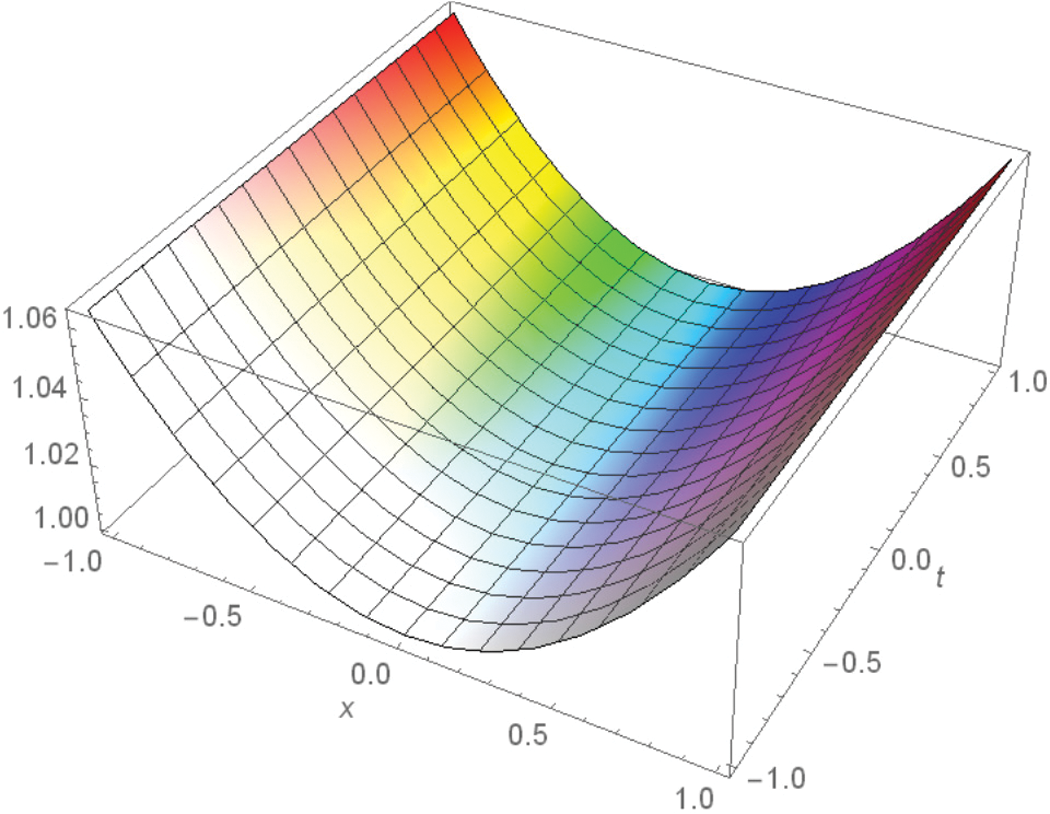
Figure 4: 3D plot of

Figure 5: 3D exact solution of
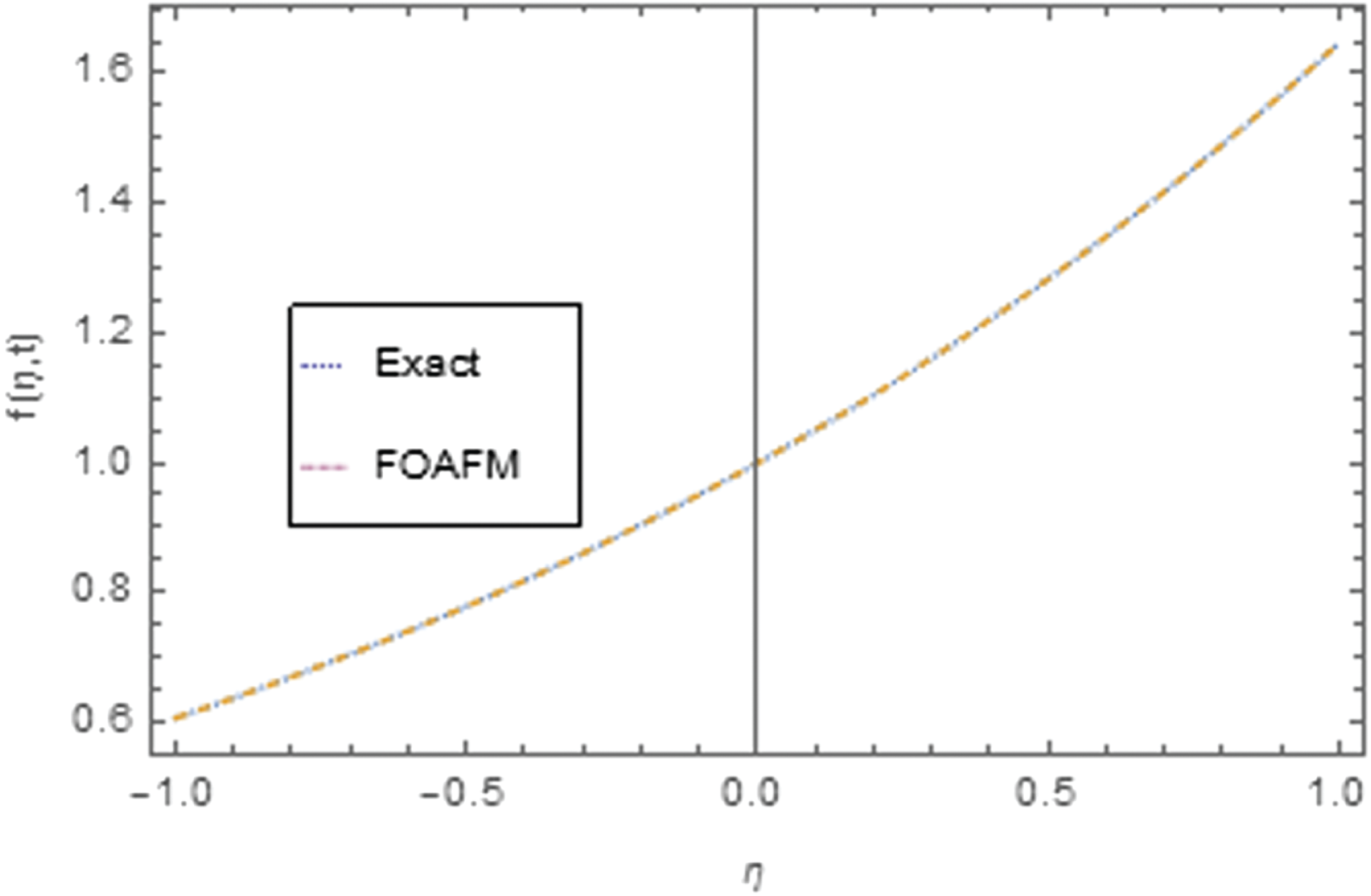
Figure 6: 2D plot of comparison of exact and FOAFM solutions
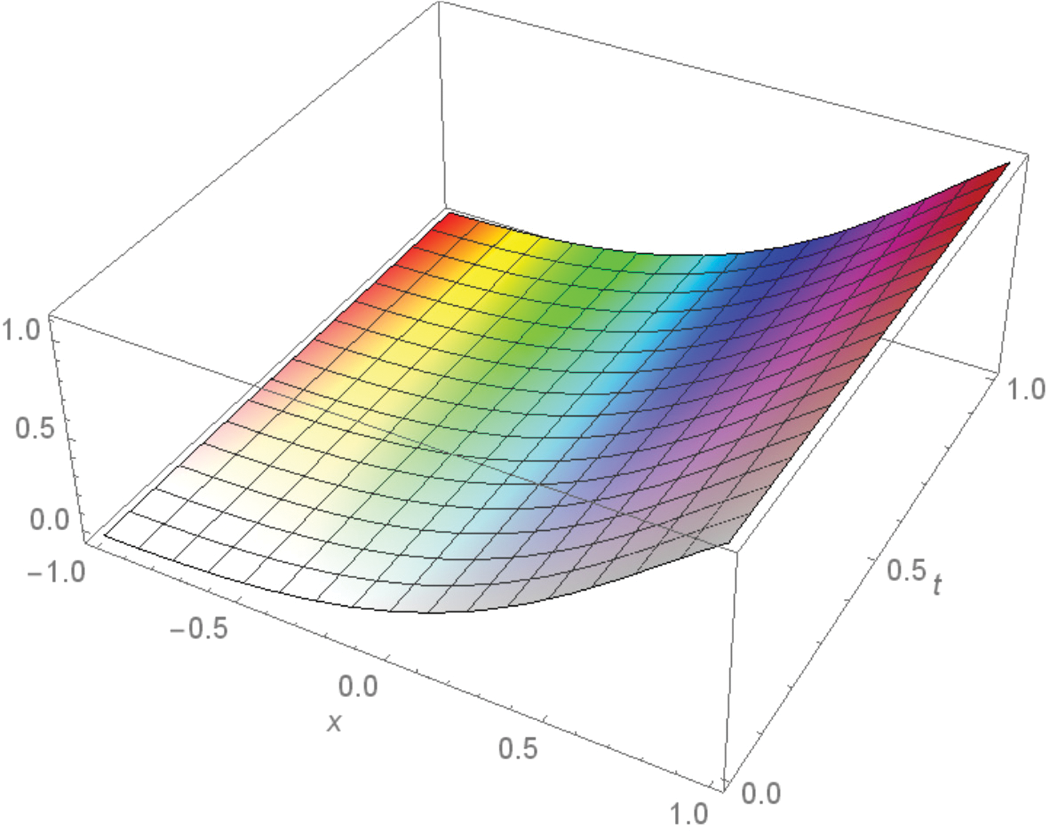
Figure 7: 3D plot of residual
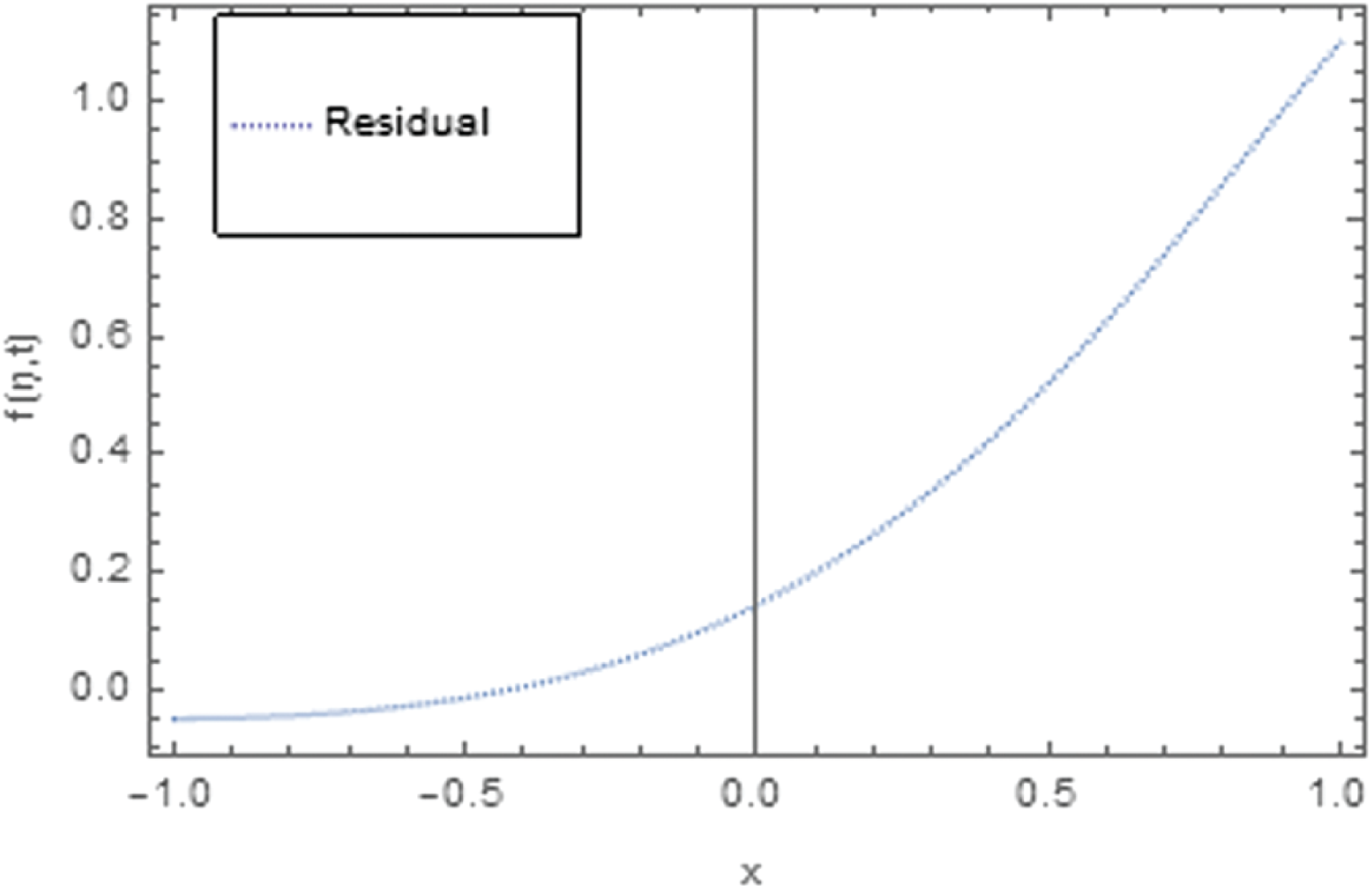
Figure 8: 2D plot of residual

Figure 9: 3D plot of residual

Figure 10: 2D plot of residual

Figure 11: 2D plot of approximate solution for
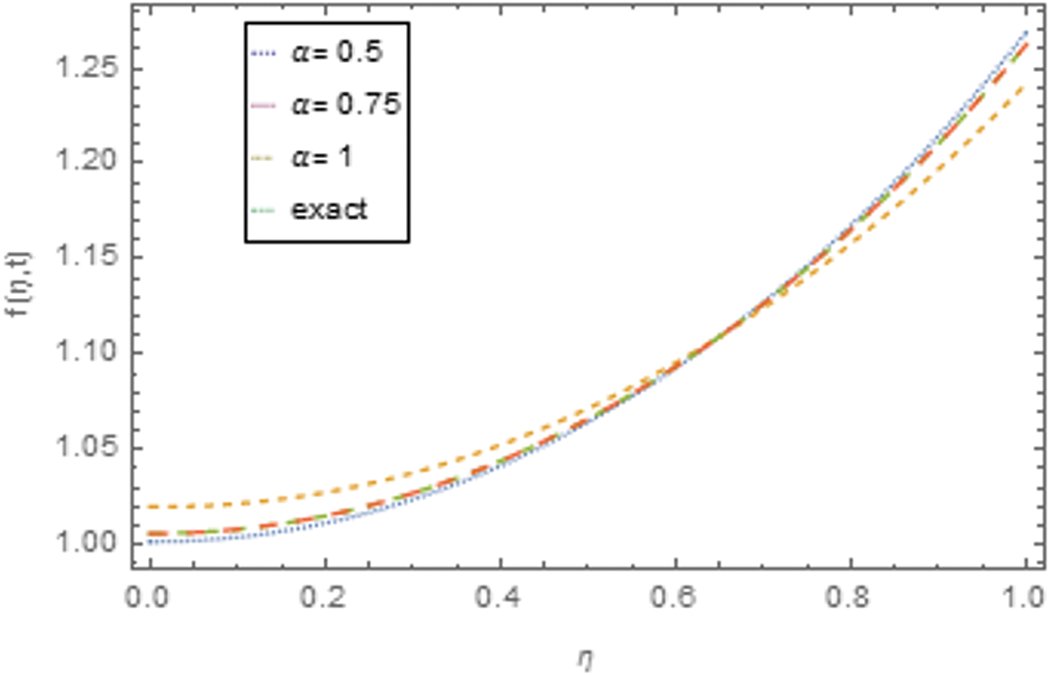
Figure 12: 2D plot of approximate solution for
In this study, a new analytical method is suggested for the solution of the Fornberg-Whitham equation. We obtained the first order series solution for the Fornberg-Whitham equation and achieved the first-order solution with high accuracy. For the accuracy and validity of our method, we compared the FOAFM results with the results available in the literature and the exact results. From the comparison, it is concluded that the suggested method is very accurate and good agreement of our results with the numerical results proves the validity of our method. FOAFM is simply applicable to linear and nonlinear initial and boundary value problems. In comparison with other analytical methods, FOAFM is very easy in applicability and provides us with good results for more complex nonlinear initial/boundary value problems. FOAFM contains the optimal auxiliary constants through which we can control the convergence as FOAFM contains the auxiliary functions
Funding Statement: The authors received no specific funding for this study.
Conflicts of Interest: The authors declare that they have no conflicts of interest to report regarding the present study.
References
1. Fellah, Z. E. A., Depollier, C., Fellah, M. (2002). Application of fractional calculus to the sound waves propagation in rigid porous materials: Validation via ultrasonic measurements. Acta Acustica United with Acustica, 88(1), 34–39. [Google Scholar]
2. Sebaa, N., Fellah, Z. E. A., Lauriks, W., Depollier, C. (2006). Application of fractional calculus to ultrasonic wave propagation in human cancellous bone. Signal Processing, 86(10), 2668–2677. DOI 10.1016/j.sigpro.2006.02.015. [Google Scholar] [CrossRef]
3. Meral, F. C., Royston, T. J., Magin, R. (2010). Fractional calculus in viscoelasticity: An experimental study. Communications in Nonlinear Science and Numerical Simulation, 15(4), 939–945. DOI 10.1016/j.cnsns.2009.05.004. [Google Scholar] [CrossRef]
4. Suárez, J. I., Vinagre, B. M., Calderón, A. J., Monje, C. A., Chen, Y. Q. (2003). Using fractional calculus for lateral and longitudinal control of autonomous vehicles. International Conference on Computer Aided Systems Theory, pp. 337–348. Berlin, Heidelberg, Springer. [Google Scholar]
5. Oldham, K. B., Spanier, J. (1974). The fractional calculus. New York: Academic Press. [Google Scholar]
6. Meerschaert, M. M., Scheffler, H. P., Tadjeran, C. (2006). Finite difference methods for two-dimensional fractional dispersion equation. Journal of Computational Physics, 211(1), 249–261. DOI 10.1016/j.jcp.2005.05.017. [Google Scholar] [CrossRef]
7. Metzler, R., Klafter, J. (2004). The restaurant at the end of the random walk: Recent developments in the description of anomalous transport by fractional dynamics. Journal of Physics A: Mathematical and General, 37(31), R161. DOI 10.1088/0305-4470/37/31/R01. [Google Scholar] [CrossRef]
8. Podlubny, I. (1999). Fractional differential equations. New York, NY, USA: Academic Press. [Google Scholar]
9. Schneider, W. R., Wyss, W. (1989). Fractional diffusion and wave equations. Journal of Mathematical Physics, 30(1), 134–144. DOI 10.1063/1.528578. [Google Scholar] [CrossRef]
10. Torrisi, M., Tracina, R., Valenti, A. (1996). A group analysis approach for a nonlinear differential system arising in diffusion phenomena. Journal of Mathematical Physics, 37(9), 4758–4767. DOI 10.1063/1.531634. [Google Scholar] [CrossRef]
11. Drzain, P. G., Johnson, R. S. (1989). An introduction discussion the theory of solution and its diverse applications. Cambridge University Press. [Google Scholar]
12. Abdel-Hamid, B. (2000). Exact solutions of some nonlinear evolution equations using symbolic computations. Computers & Mathematics with Applications, 40(2–3), 291–302. DOI 10.1016/S0898-1221(00)00161-9. [Google Scholar] [CrossRef]
13. Bluman, G., Kumei, S. (1980). On the remarkable nonlinear diffusion equation (∂/∂x)[a (u+b)−2 (∂u/∂x)]−(∂u/∂t)=0. Journal of Mathematical Physics, 21(5), 1019–1023. DOI 10.1063/1.524550. [Google Scholar] [CrossRef]
14. Chun, C. (2009). Fourier-series-based variational iteration method for a reliable treatment of heat equations with variable coefficients. International Journal of Nonlinear Sciences and Numerical Simulation, 10(11–12), 1383–1388. DOI 10.1515/IJNSNS.2009.10.11-12.1383. [Google Scholar] [CrossRef]
15. Chowdhury, S. H. (2011). A comparison between the modified homotopy perturbation method and adomian decomposition method for solving nonlinear heat transfer equations. Journal of Applied Sciences, 11(7), 1416–1420. DOI 10.3923/jas.2011.1416.1420. [Google Scholar] [CrossRef]
16. Yaghoobi, H., Torabi, M. (2011). The application of differential transformation method to nonlinear equations arising in heat transfer. International Communications in Heat and Mass Transfer, 38(6), 815–820. DOI 10.1016/j.icheatmasstransfer.2011.03.025. [Google Scholar] [CrossRef]
17. Ganji, D. D. (2006). The application of He’s homotopy perturbation method to nonlinear equations arising in heat transfer. Physics Letters A, 355(4–5), 337–341. DOI 10.1016/j.physleta.2006.02.056. [Google Scholar] [CrossRef]
18. Bellman, R. (1964). Perturbation techniques in mathematics, physics, and engineeing. New York: Holt, Rinehart and Winston. [Google Scholar]
19. Cole, J. D. (1968). Perturbation methods in applied mathematics. Waltham, MA: Blaisedell. [Google Scholar]
20. O’Malley, R. E. (1974). Introduction to singular perturbation. New York: Academic Press. [Google Scholar]
21. Liao, S. J. (1992). The proposed homotopy analysis technique for the solution of nonlinear problems (Doctoral Dissertation, Ph.D. Thesis). Shanghai Jiao Tong University, China. [Google Scholar]
22. Marinca, V., Herişanu, N., Nemeş, I. (2008). Optimal homotopy asymptotic method with application to thin film flow. Open Physics, 6(3), 648–653. DOI 10.2478/s11534-008-0061-x. [Google Scholar] [CrossRef]
23. Herişanu, N., Marinca, V. (2010). Explicit analytical approximation to large-amplitude non-linear oscillations of a uniform cantilever beam carrying an intermediate lumped mass and rotary inertia. Meccanica, 45(6), 847–855. DOI 10.1007/s11012-010-9293-0. [Google Scholar] [CrossRef]
24. Marinca, V., Herişanu, N., Bota, C., Marinca, B. (2009). An optimal homotopy asymptotic method applied to the steady flow of a fourth-grade fluid past a porous plate. Applied Mathematics Letters, 22(2), 245–251. DOI 10.1016/j.aml.2008.03.019. [Google Scholar] [CrossRef]
25. Herişanu, N., Marinca, V., Dordea, T., Madescu, G. (2008). A new analytical approach to nonlinear vibration of an electrical machine. Proceedings of the Romanian Academy, Series A. Mathematics, Physics, Technical Sciences, Information Science, 9(3), 229–236. [Google Scholar]
26. Marinca, V., Herişanu, N. (2010). Determination of periodic solutions for the motion of a particle on a rotating parabola by means of the optimal homotopy asymptotic method. Journal of Sound and Vibration, 329(9), 1450–1459. DOI 10.1016/j.jsv.2009.11.005. [Google Scholar] [CrossRef]
27. Ullah, H., Islam, S., Idrees, M., Fiza, M., Haq, Z. M. (2014). An extension of the optimal homotopy asymptotic method to coupled schrödinger-KdV equation. International Journal of Differential Equations, 2014, 1–11. DOI 10.1155/2014/106934. [Google Scholar] [CrossRef]
28. Ullah, H., Islam, S., Idrees, M., Arif, M. (2013). Solution of boundary layer problems with heat transfer by optimal homotopy asymptotic method. Abstract and Applied Analysis, 2013, 324869. DOI 10.1155/2013/324869. [Google Scholar] [CrossRef]
29. Ullah, H., Islam, S., Idrees, M., Fiza, M. (2013). Application of optimal homotopy asymptotic method to doubly wave solutions of the coupled Drinfel’d-Sokolov-Wilson equations. Mathematical Problem in Engineering, 2013, 1–8, 362816. [Google Scholar]
30. Ullah, H., Islam, S., Sharidan, S., Khan, I., Fiza, M. (2015). Formulation and application of optimal homotopy asymptotic method for coupled differential difference equations. PLoS One. DOI 10.137/journal.pone.0120127. [Google Scholar] [CrossRef]
31. Ullah, H., Islam, S., Dennis, L. C. C., Abdelhameed, T. N., Khan, I. et al. (2015). Approximate solution of two-dimensional nonlinear wave equation by optimal homotopy asymptotic method. Mathematical Problems in Engineering, 2015, 380104. DOI 10.1155/2015/380104. [Google Scholar] [CrossRef]
32. Herisanu, N., Marinca, V., Madescu, G., Dragan, F. (2019). Dynamic response of a permanent magnet synchronous generator to a wind gust. Energies, 12, 915. DOI 10.3390/en12050915. [Google Scholar] [CrossRef]
33. Abbasbandy, S. (2007). The application of homotopy analysis method to a generalized hirota-satsuama coupled KdV equations. Physics Letters A, 361, 478–483. DOI 10.1016/j.physleta.2006.09.105. [Google Scholar] [CrossRef]
34. Kumar, D., Singh, J., Baleanu, D. (2018). A new analysis of the fornberg-whitham equation pertaining to a fractional derivative with mittag-leffler-type kernel. The European Physical Journal Plus, 133(2), 1–10. DOI 10.1140/epjp/i2018-11934-y. [Google Scholar] [CrossRef]
35. Lu, J. (2011). An analytical approach to the fornberg–whitham type equations by using the variational iteration method. Computers & Mathematics with Applications, 61(8), 2010–2013. DOI 10.1016/j.camwa.2010.08.052. [Google Scholar] [CrossRef]
36. Hashemi, M. S., Haji-Badali, A., Vafadar, P. (2014). Group invariant solutions and conservation laws of the fornberg–whitham equation. Zeitschrift für Naturforschung A, 69(8–9), 489–496. DOI 10.5560/zna.2014-0037. [Google Scholar] [CrossRef]
37. Ramadan, M. A., Al-luhaibi, M. S. (2014). New iterative method for solving the fornberg-whitham equation and comparison with homotopy perturbation transform method. British Journal of Mathematics & Computer Science, 4(9), 1213–1227. [Google Scholar]
38. Merdan, M., Gokdogan, A., Yildirim, A., Mohyud-Din, S. T. (2012). Numerical simulation of fractional fornberg-whitham equation by differential transformation method. Abstract and Applied Analysis, 965367. DOI 10.1155/2012/965367. [Google Scholar] [CrossRef]
39. Wang, K., Liu, S. (2016). Application of new iterative transform method and modified fractional homotopy analysis transform method for fractional fornberg-whitham equation. Journal of Nonlinear Sciences and Applications, 9(5), 2419–2433. DOI 10.22436/jnsa. [Google Scholar] [CrossRef]
40. Abidi, F., Omrani, K. (2011). Numerical solutions for the nonlinear fornberg–whitham equation by he’s methods. International Journal of Modern Physics B, 25(32), 4721–4732. DOI 10.1142/S0217979211059516. [Google Scholar] [CrossRef]
41. Ibrahim, R. W., Ajaj, A. M., Al-Saidi, N. M., Balean, D. (2022). Similarity analytic solutions of a 3D-fractal nanofluid uncoupled system optimized by a fractal symmetric tangent function. Computer Modeling in Engineering & Sciences, 130(1), 221–232. DOI 10.32604/cmes.2022.018348. [Google Scholar] [CrossRef]
42. Liu, C., Kuo, C., Chang, J. (2020). Solving the optimal control problems of nonlinear duffing oscillators by using an iterative shape function method. Computer Modeling in Engineering & Sciences, 122(1), 33–48. DOI 10.32604/cmes.2020.08490. [Google Scholar] [CrossRef]
43. Ghasemi, M. H., Hoseinzadeh, S., Heyns, P. S., Wilke, D. N. (2020). Numerical analysis of non-Fourier heat transfer in a solid cylinder with dual-phase-lag phenomenon. http://hdl.handle.net/2263/73642. [Google Scholar]
44. Gulalai, S. A., Rihan, F. A., Ahmad, S., Rihan, F. A., Ullah, A. et al. (2022). Nonlinear analysis of a nonlinear modified KdV equation under Atangana Baleanu Caputo derivative. AIMS Mathematics, 7(5), 7847–7865. DOI 10.3934/math.2022439. [Google Scholar] [CrossRef]
45. Aljahdaly, N. H., Akgül, A., Shah, R., Mahariq, I., Kafle, J. (2022). A comparative analysis of the fractional-order coupled Korteweg–de Vries equations with the Mittag–Leffler law. Journal of Mathematics, 2022, 8876149. DOI 10.1155/2022/8876149. [Google Scholar] [CrossRef]
46. Wang, K. L. (2022). Novel approach for fractal nonlinear oscillators with discontinuities by Fourier series. Fractals, 30(1), 2250009. DOI 10.1142/S0218348X22500098. [Google Scholar] [CrossRef]
47. Wang, K. (2022). Fractal solitary wave solutions for fractal nonlinear dispersive boussinesq-like models. Fractals, 30(4), 1–8. DOI 10.1142/S0218348X22500839. [Google Scholar] [CrossRef]
48. Gupta, M. D., Chauhan, R. K. (2022). Hardware efficient pseudo-random number generator using chen chaotic system on FPGA. Journal of Circuits, Systems and Computers, 31(3), 2250043. DOI 10.1142/S0218126622500438. [Google Scholar] [CrossRef]
49. Ali, U., Ahmad, H., Baili, J., Botmart, T., Aldahlan, M. A. (2022). Exact analytical wave solutions for space-time variable-order fractional modified equal width equation. Results in Physics, 33, 105216. DOI 10.1016/j.rinp.2022.105216. [Google Scholar] [CrossRef]
50. Mastoi, S., Ganie, A. H., Saeed, A. M., Ali, U., Rajput, U. A. et al. (2022). Numerical solution for two dimensional partialdifferentialequations using SMs method. DOI 10.1515/phys-2022-0015. [Google Scholar] [CrossRef]
51. Naseem, T., Niazi, N., Ayub, M., Sohail, M. (2021). Vectorial reduced DTM for fractional Cauchy riemann system of equations. Computational and Mathematical Methods, 3(6), e1157. [Google Scholar]
52. Shoial, M., Mohyud-Din, S. T. (2012). Reduced DTM for time fractional parabolic PDEs. International Journal of Modern Applied Physics, 1(3), 114–122. [Google Scholar]
53. Wang, Q. L., He, J. H., Li, Z. B. (2012). Fractional model for heat conduction in polar bear hairs. Thermal Science, 16(2), 339–342. DOI 10.2298/TSCI110503070W. [Google Scholar] [CrossRef]
Cite This Article
 Copyright © 2023 The Author(s). Published by Tech Science Press.
Copyright © 2023 The Author(s). Published by Tech Science Press.This work is licensed under a Creative Commons Attribution 4.0 International License , which permits unrestricted use, distribution, and reproduction in any medium, provided the original work is properly cited.


 Submit a Paper
Submit a Paper Propose a Special lssue
Propose a Special lssue View Full Text
View Full Text Download PDF
Download PDF Downloads
Downloads
 Citation Tools
Citation Tools